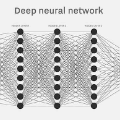Visual object recognition systems need to generalize from a set of 2D training views to novel views. The question of how the human visual system can generalize to novel views has been studied and modeled in psychology, computer vision, and neuroscience. Modern deep learning architectures for object recognition generalize well to novel views, but the mechanisms are not well understood. In this paper, we characterize the ability of common deep learning architectures to generalize to novel views. We formulate this as a supervised classification task where labels correspond to unique 3D objects and examples correspond to 2D views of the objects at different 3D orientations. We consider three common models of generalization to novel views: (i) full 3D generalization, (ii) pure 2D matching, and (iii) matching based on a linear combination of views. We find that deep models generalize well to novel views, but they do so in a way that differs from all these existing models. Extrapolation to views beyond the range covered by views in the training set is limited, and extrapolation to novel rotation axes is even more limited, implying that the networks do not infer full 3D structure, nor use linear interpolation. Yet, generalization is far superior to pure 2D matching. These findings help with designing datasets with 2D views required to achieve 3D generalization. Code to reproduce our experiments is publicly available: https://github.com/shoaibahmed/investigating_3d_generalization.git
翻译:视觉对象识别系统需要从一组二维训练视图泛化到新视图。人类视觉系统如何能够推广到新视角已经在心理学、计算机视觉和神经科学中得到了研究和建模。现代深度学习架构的对象识别能力能够很好地推广到新视角,但机制尚未得到很好的理解。在本文中,我们对常见的深度学习架构的推广到新视图的能力进行了表征。我们将其制定为有监督的分类任务,其中标签对应于唯一的三维对象,示例对应于具有不同三维方向的对象的二维视图。我们考虑了三种常见的推广到新视图的模型:(i)完全的三维推广,(ii)纯2D匹配和(iii)基于视图的线性组合的匹配。我们发现,深度模型能够很好地推广到新视图,但是它们的推广方式与所有这些现有模型不同。到超出训练集中视图范围以外的视图的外推是有限的,到新旋转轴的外推则更加有限,这意味着网络没有推断出完整的三维结构,也没有使用线性插值。然而,推广远远优于纯2D匹配。这些发现有助于设计需要2D视图才能实现3D泛化的数据集。重现我们的实验的代码公开可用:https://github.com/shoaibahmed/investigating_3d_generalization.git



